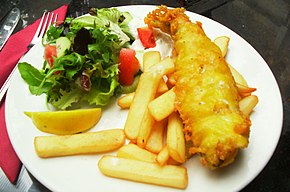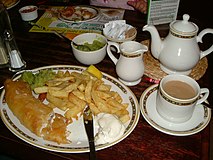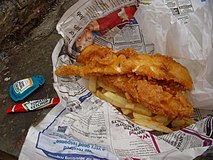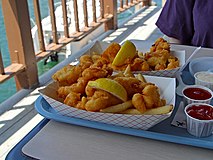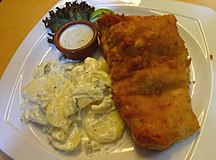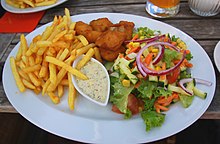fish and chips
Fish and chips (short- Fish 'n' Chips ) is a dish made in batter fried fish fillet ( fish ) and thick fried potato sticks ( chips ). They are considered the “unofficial national dish ” of the United Kingdom and are still an integral part of English and Scottish cuisine and dining culture . Although it has lost some of its popularity to international street food in recent years , the dish has maintained its primacy.
The fish
On the list of for the preparation of fish 'n' chips food fish has traditionally used the cod ( cod ) in first place, this combination is often found then on the menu as Cod Chips 'n' again. Suitable many fish with white meat, such as haddock ( haddock ), saithe ( pollock ), whiting ( whiting ) or Flounder ( plaice ). In many fish-'n'-chip shops the customer can choose from several types. Pieces of fallen dough floating in the frying oil are sometimes served as a side dish in fish-and-chip shops, mainly towards the end of the day. In a slight variation of the original name, the meal is then called Scraps 'n' Chips , but has a "rather dubious reputation". In Ireland, a variant with smoked cod is known and is considered a local specialty.
The fish and chips are baked for 4 to 5 minutes in deep-frying oil, which is heated to 185 ° C to 190 ° C depending on the oil.
The chips
The starting point of the preparation original British chips (short for chipped potato ) are edible potatoes . Real chips are consumed in South and Central England and West of Scotland predominantly with salt and malt vinegar ( salt 'n' vinegar ), in North Eastern Scotland and England with salt and Brown sauce ( salt 'n' sauce ). In Central England, the chips are preferably fried with beef kidney fat . Chips are the British version of French fries , but are usually thicker than the French fries common in Germany. In addition, chips are rather soft instead of crispy, but less fatty.
Side dishes
Occasional side dishes to fish 'n' chips are a pulp of mashed peas / pea puree ( mushy peas ), pickled onions , pickles ( gherkins ) or baked beans cooked in tomato sauce . Typical of the north of England is the variant chips and gravy (chips with gravy), which is rarely found in the south and in Scotland. Tea is often drunk with it, as fish and chip shops in Great Britain do not usually have a license to serve alcoholic beverages.
Fish, chips, tartare sauce , mushy peas (= pea puree) and lemon schnitz
Fish, chips, mushy peas , tartare sauce and tea in a pub in Bournemouth
Culture
Fish 'n' chips are rarely made at home. This is because fish 'n' chips are considered street food . They are often sold as take-away , i.e. to take away for consumption on the go or at home. In the course of gentrification , the cultural refinement of the specialty, upscale restaurants now also have the dish on their menus . In many pubs it is also part of the culinary offer best described by the English term pub food . With Harry Ramsden's existed since 1928 on Fish 'n' Chips specialized restaurant chain. Still, traditional fish 'n' chip consumption is still linked to the specialized and usually family-owned fish 'n' chip shops found in almost every UK city. In these the "freshly bought fish in the morning at the market" is served on unprinted paper.
Traditionally, fish 'n' chips are eaten with the fingers. However, here too, modern customs have often supplanted tradition, so that nowadays small wooden or plastic forks are almost always handed out. Fish 'n' chips are particularly popular on Friday and Saturday evening - originally this may have had a religious meaning; today consumption is mainly related to the culture of night clubbing . Fish 'n' chips then serve as a strengthening meal before the actual start of the evening.
Fish 'n' chips in styrofoam box
history
The origin of fish 'n' chips is still in the dark today. The dish probably came into the country on separate routes: the chips from France and the way the fish was prepared with Jewish immigrants. In any case, it is known that fish 'n' chips did not become a national dish until the 19th century. The basis of its success were small family businesses that traditionally and often loudly advertised a wide variety of food for sale on the streets of London and the large industrial cities of northern England. From the very beginning of its settlement, London was a center of the fish trade, while in the north the potato was widely used as a staple food. The first chips, however, were not as now, potato sticks, but deep-fried pieces of bread ( fried bread ). With the shortage of wheat , however, the potato soon appeared as a substitute.
The Jewish immigrant Joseph Malin is officially considered to be the founder of the first fish 'n' chip shop in London's East End in 1860. However, the first fish 'n' chip shops opened in various ways in the 1850s and 1860s Boroughs of London and Oldham , Lancashire in 1863 . They were made possible by the expansion of fishing far into the Atlantic and by the railroad , which brought fresh fish from the coasts to the capital overnight for the first time, and there they blended seamlessly into the existing culture of the street stalls and pastry shops . According to official estimates, there were already around 25,000 shops throughout the kingdom in 1910, which were organized into the National Federation of Fish Friers from 1913 onwards . During and after the First World War , fish 'n' chips made a significant contribution to the political and social stability of Great Britain. The British working class could afford the inexpensive and nutritious meal and satisfy the worst hunger of the 20th century. The Northern Counties Federation of Fish Friers wrote in the postwar Walton period with good reason :
"We stood between the Government and grave discontent […] and, more than any other trade in the country, between the very poorest of our population and famine and revolt."
"We stood between the government and the worst dissatisfaction [...] and more than any other trade in this country between the poorest of the poor and famine and revolt."
But not only social support, but also entrepreneurial spirit was evident in connection with fish 'n' chips: in 1936 a supplier in Keighley first came up with the idea of delivering the dish from the sidecar of his motorcycle to the newly emerging workers' settlements at that time - the first fast food delivery service was born. Despite all the restrictions required by the war, fish 'n' chips were not rationed by the British Ministry of Food as a substantial and cheap meal even during World War II and were also used to supply the fighting troops. Citizens evacuated from cities to rural areas due to the war were supplied with special fish 'n' chip carts.
It was not until the end of the 20th century that the popularity of this traditional specialty fell sharply in Great Britain: kebab stands and curry houses increasingly took on the role of traditional fish-'n'-chip sellers, especially in the city centers. Even so, at the beginning of the 21st century, 60,000 tons of fish and 500,000 tons of potatoes were still being processed into fish 'n' chips in Great Britain. Between 250 and 350 million servings are sold in the British Isles each year. In the meantime, there are more and more variants of fish 'n' chips that differ more or less from the traditional preparation, such as thin French fries with whole peas. Some upscale British restaurants offer refined versions of fish 'n' chips, as do award-winning fish 'n' chip shops. Heston Blumenthal demonstrated on BBC television in 2006 how he cooks fish 'n' chips in his restaurant The Fat Duck .
The British national dish is now finding new fans around the world as the “flagship product of British cuisine”. Fish 'n' chip shops not only exist in Ireland , Canada , Australia , New Zealand , South Africa and the USA , but also in the People's Republic of China and Oman . There is a special cultural connection to Italy: the Tuscan town of Barga celebrates its bond with Great Britain every August with the festival La Sagra Del Pesce e Patate - the festival of fish 'n' chips.
Fish and chip joint in Broadstairs , Kent (2008)
Fish and chip shop in Shrewsbury (2001)
Fish 'n' Chips in San Diego , USA (2004)
Related dishes
Dishes that also consist of fish in batter are, for example, the German fried fish or the Dutch kibbeling . Since these are also sometimes consumed with French fries , they can be seen as international relatives of the fish 'n' chip.
The breaded Christmas carp is a specialty that is served at Christmas in Central Europe (Franconia, the Czech Republic, Poland, Hungary). The former Lent is usually breaded in beer batter , fried and served with boiled potatoes or potato salad. The New Year's carp, on the other hand, remains unbreaded as blue carp.
Fried fish with potato salad and tartar sauce
Kibbeling (middle, top) with french fries, tartar sauce, colorful salad
Breaded Christmas carp with boiled potatoes, cucumber salad
Others
- The use of old newspapers as wrapping paper mainly served to keep the food warm and to soak up the fat. In the 1980s, new hygiene regulations banned the wrapping of fish 'n' chips in newspaper. At that time, the abrasion of the printing ink was even higher than with the UV-curing printing inks commonly used today . Today, for nostalgic reasons, many fish-and-chip shops have once again got greaseproof wrapping paper in the style of old London newspapers.
- During the landing of the Allied forces in Normandy in World War II on D-Day , British soldiers identified with the question fish? and the answer chips .
- The British Army used today (2009) as unofficial, memorable mnemonic the acronym of "fish and chips" for the local and urban warfare . Fish here means "fighting in someone's house" (= fight in someone's house ) and chips "in people's streets Causing havoc" (= causing havoc on public roads ).
- The Seafish Industry Authority introduced the National Fish and Chip Award in 1988 for the best fish 'n' chip shops to promote the food and raise quality standards.
literature
Non-fiction
- John K. Walton: Fish & Chips and the British Working Class. 1870-1940 . Leicester University Press, London a. a. 2000, ISBN 0-7185-2120-X , (English), limited preview in Google Book Search.
- Mark Petrou: Fish and chips. A national treasure. Celebrating 150 years of Britain's favorite dish. Gardners Books, 2010, ISBN 9780956609502 , Review:.
- Panikos Panayi: Fish and Chips: A History. Reaction Books, London 2014, ISBN 978-1-78023-393-2 , limited preview in Google Book Search.
Fiction
- Roddy Doyle : Fish and Chips. Novel. Translated by Renate Orth-Guttmann . Krüger, Frankfurt 2001; Fischer Taschenbuchverlag, Frankfurt am Main 2002, ISBN 978-3-596-15302-2 , (English original edition: The Van (1991), published in The Barrytown Trilogy (1992): The Commitments / The Snapper / The Van ).
Movies
- Fish & chips . (OT: The Van. ) Feature film, Ireland, 1996, 96 min., Director: Stephen Frears , social satire.
- 150 years of fish 'n' chips. Videoblog , Germany, 2010, 6:01 min., Director: Annette Dittert , production: Tagesschau.de , series: London calling , first broadcast: June 12, 2010, summary, ( memento from June 15, 2010 in the Internet Archive ).
- Heston Blumenthal : In search of the perfect pleasure. Fish & Chips. (OT: In Search Of Perfection. Fish & Chips. ) Cooking show , Great Britain, 2006, 28:10 min., Production: BBC , Series: In Search Of Perfection , German first broadcast: January 8, 2009 on RTL Living , synopsis of television series .de .
- Fish 'n' Chips: the British national dish is celebrating its birthday. TV report, Germany, 2010, 5:00 min., Director: Sarah Judith Hofmann, production: Deutsche Welle , series: euromaxx highlights , first broadcast: October 31, 2010, online video .
- Fish & Chips, what else? Travel report and cooking show , Germany, France, Austria, 2012, 43 min., Director: Florian Schewe, production: arte , zero one film, ORF , series: The culinary adventures of Sarah Wiener in Great Britain. (Part 1 of 10), first broadcast: June 11, 2012, film information from arte, ( memento from September 23, 2015 in the Internet Archive ), with a prescription .
Web links
- As British as Fish and Chips. In: National Federation of Fish Friers (History and Dates of the National Dish )
- National Fish and Chip Awards. In: seafish.org (= The Seafish Industry Authority )
- Video: Fish 'n' Chips: the British national dish is celebrating its birthday. In: Deutsche Welle / euromaxx , October 31, 2010, 4:56 min.
Individual evidence
- ↑ dpa : Hot and greasy. 150 years of fish and chips. In: Stuttgarter Nachrichten , March 11, 2010: “And despite the competition from doner kebabs, burgers, pizza and Indian curry: fried fish and fries are still number one in fast food on the island. 300 million servings sold last year speak for themselves. "
- ↑ Video: Fish 'n' Chips: the British national dish is celebrating its birthday. In: Deutsche Welle / euromaxx , October 31, 2010, from 1:22 min.
- ↑ dpa : Hot and greasy. 150 years of fish and chips. In: Stuttgarter Nachrichten , March 11, 2010.
- ↑ Fish & Chips, what else? ( Memento of August 3, 2012 in the Internet Archive ). Cooking documentary with Sarah Wiener , June 11, 2012.
- ^ Fish & Chips - The Nation's Favorite. ( Memento from October 17, 2015 in the Internet Archive ) In: sugarvine.com , March 2004: “And eating thick-cut chips is healthier than thin-cut fries because they soak up less fat.” (= And eating thick-cut chips Fries are healthier than thinly sliced french fries because they absorb less fat.)
- ↑ Harry Ramsden's Boss Undercover. In: Fame Magazine , July 28, 2010.
- ↑ Don Mosey & Harry Ramsden, Jr .: Harry Ramsden: The Uncrowned King of Fish and Chips. Dalesman, Clapham 1994, ISBN 978-1855680883 .
- ↑ a b Josef Pömmerl: As British as tea and the queen. ( Memento from January 18, 2015 in the Internet Archive ). In: Main-Echo , January 13, 2010.
- ^ A b John K. Walton: Fish & Chips and the British Working Class. 1992, p. 24, limited preview in Google Book Search, (English).
- ↑ Digression into English food culture. ( Memento of March 26, 2010 in the Internet Archive ), 2010.
- ↑ Jay Rayner: Enduring love. In: The Observer , January 19, 2003, accessed December 23, 2019.
- ^ John K. Walton: Fish & Chips and the British Working Class. 1992, p. 25, (English), limited preview in the Google book search.
- ^ John K. Walton: Fish & Chips and the British Working Class. 1992, p. 15, (English), limited preview in the Google book search.
- ^ Quote from the Northern Counties Federation of Fish Friers . In: John K. Walton: Fish & Chips and the British Working Class. 1992, p. 17, footnote, (English), limited preview in the Google book search.
- ↑ Walton, Fish and Chips and the British Working Class , 1992, p. 148, limited preview in the Google book search.
- ↑ Walton, Fish and Chips and the British Working Class , 1992, pp. 19f., Limited preview in the Google Book search.
- ^ Buying a Fish and Chip Shop. ( Memento of June 10, 2007 in the Internet Archive ). In: businessesforsale.com , July 14, 2006.
- ^ Fish & Chips - The Nation's Favorite. ( Memento from October 17, 2015 in the Internet Archive ) In: sugarvine.com , March 2004, last paragraph.
- ↑ a b Alice Ritchie: British national dish. Fish and Chips - a fatty favorite dish turns 150. In: Die Welt , April 7, 2010.
- ↑ Felicity Cloake: How to cook perfect battered fish. In: The Guardian , September 29, 2011.
- ↑ Jeremy Repanich: Watch a 3-Michelin Star English Chef Try to Perfect Fish and Chips. Heston Blumenthal of the Fat Duck uses modern techniques to perfect an enduring classic. In: Robb Report , June 23, 2018, with video, 7:42 min.
- ^ Heston Blumenthal's Beer & Vodka Battered Fish & Chips. In: thefooddictator.com , November 15, 2017, accessed December 23, 2019.
- ↑ Glenys Casci: La Sagra Del Pesce e Patate. ( Memento from January 18, 2015 in the Internet Archive ). In: scotsitalian.com , 2008, (English).
- ↑ Ursula Brekle: New Year's carp. In: sachsen-lese.de , accessed on December 26, 2019.
- ↑ dpa : Hot and greasy. 150 years of fish and chips. In: Stuttgarter Nachrichten , March 11, 2010: “To keep prices as low as possible, fish and chips were originally served in the tabloid of the previous day. However, since the 1980s and the introduction of modern hygiene regulations, this custom has been yesterday's frying fat. "
- ↑ Veronika Schmidt: Can you eat printer's ink? In: Die Presse , August 30, 2010.
- ↑ Fish & Chips - Great Britain's delicacy. In: speisekarte.de , March 17, 2010.
- ↑ As British as Fish and Chips. #Feeding the nation. In: National Federation of Fish Friers , 2019, accessed December 23, 2019.
- ↑ Chris Hunter: Eight Lives Down: The Most Dangerous Job in the World in the Most Dangerous Place in the World . Random House , 2009, ISBN 978-0-553-38528-1 , pp. 204 .
- ↑ National Fish & Chip Awards Frequently asked questions (FAQ): History. In: seafish.org , 2019, accessed December 23, 2019.
- ^ National Fish and Chip Awards. In: seafish.org .
- ↑ Businessman publishes fish and chip guide to Britain's favorite take-away. In: Ely Standard , September 23, 2010; Petrou in the online video of Deutsche Welle , October 31, 2010.
